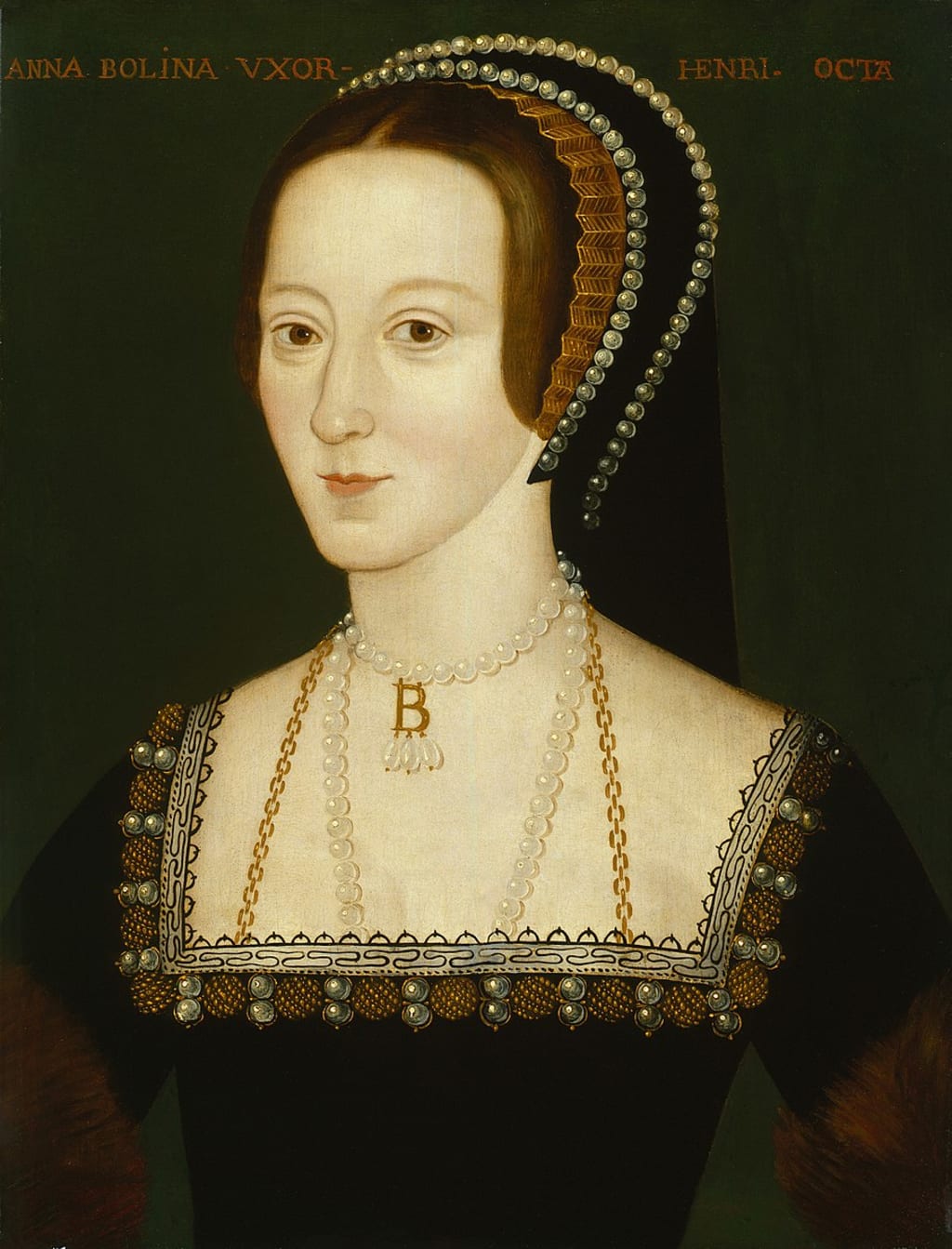
I remember, as a child, going to visit the Tower of London with my parents. I was always fascinated with British history, and the Tudors in particular. It was there that I first learned about Anne Boleyn, and she's been floating in the back of my mind like a ghost ever since.
I never fully understood her story - I've learned since that no one really does understand it. What many of us do know is that she was Henry VIII's second wife, and that she was beheaded - thanks to that catchy rhyme they teach you in school: divorced, beheaded, died, divorced, beheaded, survived. How convenient that these six women's traumas can be neatly tied up together in this way, so we may feel satisfied without actually delving into the identities of them as individuals.

Anne Boleyn in particular has been a controversial figure for 500 years - but it was the mystery surrounding her which drew me to her as a child. Today, let's demystify her a bit.
Anne did not just randomly appear in Henry VIII's court one day ready and willing to stir up trouble. In fact, Anne was a young woman (though her year of birth is debated) who had already made a great impression on royals and nobles in various royal courts across Europe. She was seen as an honourable, intelligent woman who was well-educated in politics and international affairs, as well as fluent in French and talented in dancing and singing.
Anne was passionate - but not about flirting with Kings and becoming Queen for the sake of a nice tiara. Spending her formative years in France during the religious reformation, Anne had developed a belief system which questioned the authoritative and oppressive nature of the Catholic church at the time, and it was against this that she passionately fought.
When Anne returned to England in 1522, serving as a maid of honour to Queen Catherine, Henry's first wife, it was not long before the King was taken by her charm and began to pursue her. Many historians say that Anne Boleyn was a beguiling temptress, who played games with the King to win and keep his attraction. However, we know that she refused to become his mistress, and often left court for some peace and seclusion at home in Hever Castle.
It was most likely Henry's intense desire for a male heir, not his love for Anne Boleyn, which led to his seeking a legal separation from his first wife, Catherine of Aragon. They had been married since 1509 and had one surviving child: a daughter, Mary.
After years of considerable aggravation, arguments with the clergy, and uproar from many of Henry's subjects who supported Queen Catherine, England was finally declared independent of Rome in 1532. King Henry was now the Supreme Head of the Church in England, and could finally divorce Catherine and marry Anne Boleyn. Many have claimed this divorce from his wife and from Rome to be the most 'romantic gesture' to his true love - but I personally find this quite difficult to believe, since he did have her murdered only two years later.
Don't worry, we'll get there soon.
Henry and Anne married in secret in November 1532. She soon became pregnant and, to legalise the first wedding considered to be unlawful at the time, there was a second wedding service in January 1533. Catherine was formally stripped of her title, and Anne was crowned Queen Consort on 1 June 1533 at Westminster Abbey, with the St Edward's Crown which had previously only been used to crown monarchs. Interestingly, she was the last queen consort of England to be crowned separately from her husband. At this point, it is clear that Henry wanted to demonstrate his very high opinion of Anne, but some suggest that this may have been because her pregnancy was visible, and nearly all of the royal physicians and astrologers had confidently predicted that the baby was male.
In September, Anne gave birth to baby Elizabeth (future Queen Elizabeth I). The birth of a girl was immensely disappointing to the king, and the traditional jousting tournament for the birth of an heir was cancelled. Queen Anne had numerous subsequent pregnancies - though the exact number and details are not known - however except for Elizabeth, they all ended in miscarriage or stillbirth.

Her apparent failure as a heir-producing machine was not the only reason she lost favour with members of court, and the general public. While her intelligence, wit and political opinion were attractive as a potential mistress, these were features unacceptable in a wife. She clashed with Henry's chief minister Thomas Cromwell over the distribution of church funds: she believed the money should be sent to charitable and educational institutions for the poor, whereas Cromwell believed it should be divided between the King and himself.
Not only that, but when news of Catherine of Aragon's death reached the royal court, rumours began to circulate that Anne had poisoned her Catherine. This was believed due to the finding during Catherine's embalming that her heart was blackened - likely due to cancer, not poisoning, but this was not understood at the time.
As public opinion of Queen Anne deteriorated, so too did Henry's. His desire for a male heir only intensified with every lost pregnancy, and by early 1536, Henry declared that he had been seduced into marriage by witchcraft. Soon, accusations of adultery and even incest were being brought into consideration, and she was charged with high treason. There is no evidence of any of these accusations, and in all likelihood they were entirely fabricated to suit the king's wish to marry again and finally secure a male heir.
Nevertheless, Anne had no chance of defending herself against these claims. The men she was claimed to be involved with, including her own brother, were tortured, tried, and condemned to death.

On the 19th May 1536, Anne Boleyn herself was executed. She was buried in an unmarked grave in the Chapel of St Peter ad Vincula. Her skeleton was identified during renovations of the chapel during the reign of Queen Victoria, and Anne's grave is now identified on the marble floor.
So why, these hundreds of years later, do we still care about Anne Boleyn's story? Perhaps I should rephrase - do we care? Of course the fact that I'm writing about her shows that I do, but perhaps it's just me - although the numerous television adaptations, books, and movies depicting the almost-mythical Tudors would suggest I can't be alone in this.
Perhaps that's exactly what it is. Their stories, the stories of centuries past, feel fictional to us now. There will always be an element of fiction in any retelling of history, because we can't possibly know what it was really like to be there. The time of the Tudors; of bejeweled kings and queens, brave knights and jousting tournaments, maidens in distress and epic love stories, feels so far away to us, so fantastical, that we imagine those times as storybook tales. We know Anne Boleyn was a real person, somehow, but we can't picture her. Who can picture someone that existed 500 years ago?
The fact that she was a real person, with thoughts and dreams and hobbies and desires, just like you and I, but that she existed in a reality so different to what we know, is what makes us so interested in her. The fact that she had such an extraordinary life and tragic death, is what keeps the memory of her alive today. And the mystery lingering around her is what makes her a legend.
We'll never know what Anne Boleyn was really like. We'll never know what her favourite colour was, or how her laugh sounded, or what lullabies she sang to get her daughter to drift off to sleep. We don't even really know what she looked like.
But we do know this: Anne Boleyn was a young woman, who had benefitted from every privilege possible for women in her time, who was grateful for those privileges, whose motto was 'the most happy', and who fought for others less privileged than herself. She had a powerful voice, and for that, and for her failure to adequately fulfil the role of Tudor wife, she was punished with a brutal and inhumane death. Her voice has carried through the centuries and continues to inspire us today, long after those attempts to silence her.

About the Creator
Mabel Holes
medical student in the UK, who spends her spare time writing ✨
instagram: @mabelholes






Comments
There are no comments for this story
Be the first to respond and start the conversation.